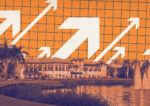Trending
Check out the royal family’s property portfolio
Queen Elizabeth and Prince Charles own billions of dollars worth of … castles

There’s property rich, and then there’s Royal Property Rich.
The Wall Street Journal has put together a guide to chunks of the billion-dollar property portfolio of Queen Elizabeth and Prince Charles, shining a light on their extensive real-estate holdings that include country houses, townhouses, cottages, farmhouses, city apartments and, of course, castles.
At the top of the list of eye candy is the building most familiar to Americans: Buckingham Palace, the queen’s official London residence which has been in the family since King George II, 12 years before a certain tea party, purchased it in 1761 for a little less than $28,000. That’s more than a few pence over $6 million in today’s dollars. It turned out to be a pretty savvy move on his part, as it is now estimated to be worth about $1.3 billion.
Citadels in the family include Windsor Castle in Berkshire, England, where the princess hid out during World War II bombing raids on London; the Palace of Holyroodhouse in Edinburgh, Scotland, is practically a studio apartment, with just over 87,000 square feet of space and 289 rooms; Balmoral Castle and Estate in Aberdeenshire, Scotland, a favorite late-summer, early fall hideaway for the royals; and Sandringham Estate, the birthplace of Princess Diana, whose parents rented the Park House there.
And there’s plenty of stuff on the other side of the moat.
Prince Charles purchased an 18th-century farmhouse on 192 acres in Carmarthenshire, Wales in 2007 for $1.59 million. It’s now valued at about $3.6 million.
Then there’s the restored three-bedroom, two-bathroom cottage the prince owns in the village of Viscri in Romania, and, about two hours away, the five-bedroom, five-bath home with a guest cottage in Zalánpatak. The value of those properties, the newspaper says, is unknown.
Finally, there’s the big moneymaker: Prince Charle’s Duchy of Cornwall in (naturally) Cornwall, England, where revenue from the 130,125 acres of farmland, forest, coastline, and residential and commercial properties ensures Chuck’s pockets never runs out of cash.
[Wall Street Journal] — Vince DiMiceli




